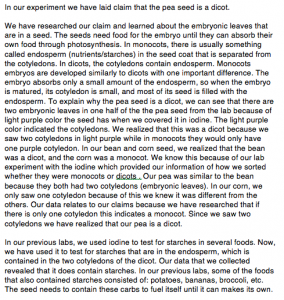Some thoughts
Writing improves thinking because it requires an individual to make ideas explicit and to evaluate and choose among the necessary tools to communicate effectively. Writing can provide an opportunity to think through material and arguments and lead to the use of higher order thinking.
For effective science writing:
- Students have interesting, meaningful, real-world experiences and investigations to write about
- Prompts that clearly relate the task to a particular science phenomenon or laboratory experience
- Model the thinking and writing students are to produce
- Concentrate on communicating ideas clearly, even if spelling and grammar aren’t perfect
- Let them have a chance to talk out their ideas before they write, even in groups
- Abundant resource in the classroom for inspiration, vocabulary, images…
- Give constructive feedback on writing to clarify thinking
Types of writing
Writing to learn
journals, logs, micro-themes, responses to written or oral questions, summaries, free writing, notes and other writing assignments that align to learning ideas and concepts. Quick writing – exit slip, column notes/t-notes, summarize the main ideas from your notes
Writing to demonstrate knowledge
specific questions or problems, letters, projects, and more formal assignments or papers prepared over weeks or over a course, write a technical manual, investigative report, i-search paper (question they want to know at the beginning of the year and they research as time goes on), issues in school, environment, etc., narrative – fictional writing as an object – cell part?, animal in environment. Pourquois stories of fictional accounts of how something came to be about (animal trait, natural event). Research report. Learning stations.memes. position paper, change a variable in an experiment
Argumentation
- you have a coherent argument where all claims work together to support your overall point of view
- your reasoning for each claim is clear to the reader
- your assumptions are valid
- you have evidence for every claim you make
- you use evidence that is convincing and directly relevant
Informational writing/Descriptive
summary, results of an experiment. identify, report, record, summarise and define. Notes from lab – one half of the page with the results and the other half with their thinking and their reflections
Example: Biomolecules in Foods lab
Reese’s Puffs had simple sugars and starches present, while lipids and proteins were absent. Marshmallow fluff only had simple sugars present, with starches, lipids, and proteins absent. Finally, peanut butter had simple sugars and starches absent, but lipids and proteins were present.
According to the nutrition label, lipids and proteins should have been present in Reese’s Puffs, but they did not test positive in our lab. In marshmallow fluff, all the calories were from carbohydrates, with most of the carbs being sugars, so the tests we did were correct for this. Peanut butter, according to MyFitness Pal has sugar in it, so it should have tested positive for simple sugars. The rest of the information is correct.
Reese’s Puffs and sugar cookies both had simple sugars and starches present, but sugar cookies had lipids in addition to that. I believe that this is because sugar cookies are made with butter. When we take in simple sugars, which both the cereal and cookies have, our body release insulin to help digest the sugar, and then it will store it as fat. If we take in too much sugar, lots of insulin will be released because of a spike in our blood sugar, and so after about 30-60 minutes, we will get a “sugar crash,” which is just our blood sugar dropping way below its normal. Starches, however, take a longer time to breakdown, so our blood sugar stays closer to its normal. Fat, on the other hand, gets stored in our muscles, belly, and liver where it does us no good. Knowing this information, marshmallow fluff would be terrible for you because it is all sugars and simple sugars. However, fruit, which is only simple sugars, should spike your blood sugar, right? Wrong. Because fruits have lots of fiber, the simple sugars that they do have get absorbed by the bloodstream much slower. Not to mention, fructose, the sugar in most fruits, is automatically absorbed into the liver, so it won’t affect your blood sugar. The remaining sugars in fruit are not enough to cause a big difference in blood sugar levels. Peanut butter and venison jerky are similar because they only contain lipids and proteins. Proteins are digested in our body by being broken down into lots of amino acids. Just a side note, chewing food well increases its surface area and leads to an easier digestion.
Investigative writing
Writing for a specific audience
Narrative writing
writing that tells the reader about a particular event(s) that took place. Common narration writings: personal essays, short stories, novels, poetry. Future writing? Take a trend and forecast possible future scenarios. What are the underlying causes that created this trend? How likely is it that those causes will stay the same, increase, or decrease in the future? What new developments might alter the trend? If this trend changes, intensifies, or decreases, what impacts will it have? Develop the scenarios. Video book talk. Narrate a concept.
Telling a story of an environmental problem from the future
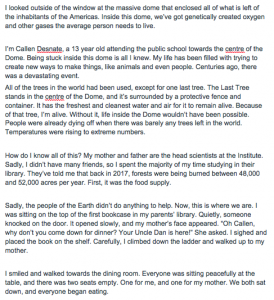
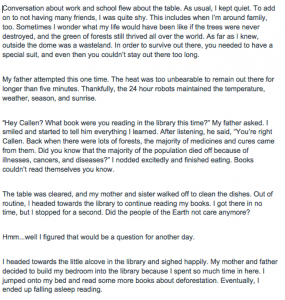
Analytical
Cause/effect, analyse, compare, contrast, relate, examine. Prompt to prove, use text to prove it. Apply it to the prompt.
CER (Claim-Evidence-Reasoning) example
Make a claim as to whether a pea seed is a monocot or dicot. The claim is one sentence and is what you start with.
Provide evidence. Write a paragraph that uses data from the lab to support your claim. Your data must be appropriate, sufficient, and scientifically accurate.
Provide reasoning. Write a paragraph that shows why the data counts as evidence to support the claim and includes scientific principles such as structure and function of plant parts, etc.
Example CER response
Journaling/metacognition
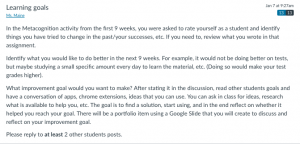
Example Rubrics
1. Example Checklist Scoring Guide
Description of science phenomenon
___ Science concepts described are clear and concise
___ Substantial depth of concepts
___ Organization is clear, focused, and unified
___Images or photos are clear and includes a description
___Data is included in the graph
___A list of resources is provided
Extension of science concepts
___ Imagination is used
___Challenges/problems are clear and concise
___Clear description for different or similar uses of the system is available
2. CER (Claim-Evidence-Reasoning) rubric
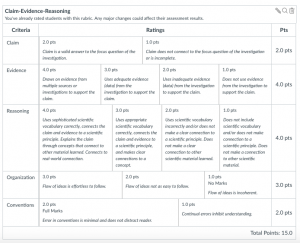
3. Single point rubric
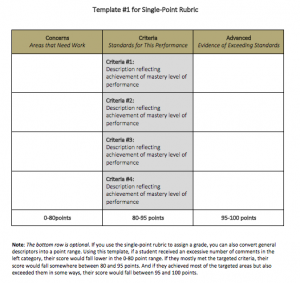
Single-Point-Rubric-Template-1
4. Essay analytical rubric
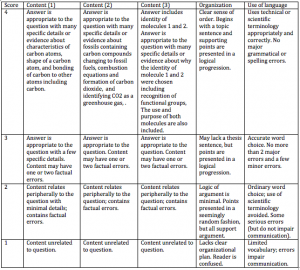
Resources
https://www.ncbi.nlm.nih.gov/pmc/articles/PMC1885902/
https://www.exploratorium.edu/education/ifi/inquiry-and-eld/educators-guide/science-writing
https://www.eduplace.com/science/profdev/articles/bowers.html
https://www.michigan.gov/documents/mde/Science_WAC_2_3_264454_7.pdf
